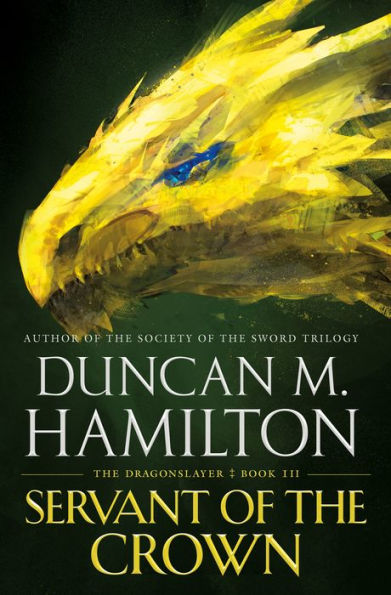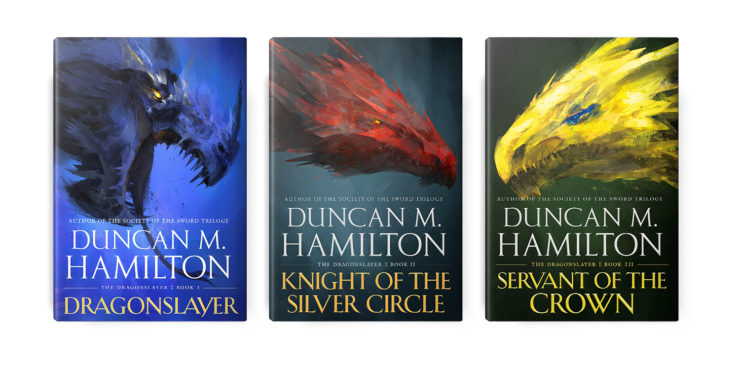In Servant of the Crown, Duncan Hamilton completes his Dragonslayer Trilogy, seeding the world and the narrative with potential plots and threats for future books, while also working to wrap up the major plotlines of the first two novels.
Spoilers ahead for the entire series.
At the end of Knight of the Silver Circle, some applecarts have been upset and in a classic three part structure, things are not going well for Gill, Solene and the forces opposing the machinations of the Prince Bishop Amaury. The King, struck by Amaury’s magic has been supplanted by Amaury as Regent, looking to cement that role as a permanent regent, or Lord Protector (shades of Cromwell!). Amaury’s greatest agent, his daughter Ysabeau, has captured the last Cup and is bringing it to her father. With the power of the Cup, Amaury’s power over Magic will be even more potent. And worse, that Cup is needed because it turns out to be the key to Uplifting Dragons from unintelligent dangerous brutes into sentient beings.
And with all of this in the air, we come to the third and final book in the series, Servant of the Crown.
Buy the Book


Servant of the Crown
For the most part, we remain in three points of view, Gill, Solene, and in the opposition, Amaury. Once again, Hamilton does a good job with his Cardinal Richelieu/Three Musketeers inspired adversary, giving him rational and solid reasons for his actions. He does mostly hew, if we are talking movie adaptations of the Musketeers, to a Heston rather than Curry or Waltz sort of mode. It doesn’t diminish the actions he does, nor does it make it less of a villain, but you can kind of see his point of view, as self serving and self dealing as it is, as he opposes the heroes and tightens his grip on power. The kingdom under the Prince Bishop feels as precarious as France was in the 17th century, with social, religious and political conflicts making the kingdom a fragile institution at best. There is a real sense of a tide coming in to undermine the sand castle of the edifice that Amaury is trying to control.
The story of Servant of the Crown again centers on Gill and Solene. Gill’s opposition to Amaury, political and personal both, drives a lot of the narrative and the action beats, and Hamilton uses Gill, especially for a lot of his set pieces. Be it a battle between rival claimants to the throne, or trying to reach and deal with the Prince Bishop in his lair, Gill and his sword and his extraordinary strength come to the forefront once more and the clash of steel and conflicts sing across the page. The end of the Renaissance feel to the world, where swordsmen like Gill might represent an institution that has seen better days, the rise of mercenary companies, and the riven state of kingdoms trying to become nations run primarily through him and his points of view.
Solene, on the other hand, represents the return of magic and the rebirth of long lost arts to the world—akin to the revival of Classical thought, philosophy, and knowledge during our own Renaissance. Her prodigal power with magic does not mean that all problems can be solved with brute force sorcery, and she shows cleverness and inventiveness in using magic in new ways to solve problems as they oppose the Bishop’s schemes. And while she might sometimes just want to be a baker and bake bread, Solene is a force of social change. This really gets its play in a set piece where it is up to Solene to deal with a dragon one on one, but not in the way you might expect.
Societies under fracture under different lines are interesting to read when depicted well, and the Mirabaya in Hamilton’s third novel has multiple fault lines for the author to exploit and show the fragility of institutions. And yet at the same time, since this is not a grimdark novel, this does not all end in anarchy and destruction. Heroic sacrifice, action and striving prevail, although not without cost and sacrifice. That’s a message and an ethos I can get behind in the year of this virus. And it’s written with a popcorn sensibility at its core, making it page turning, exciting, and fun to read. That’s not nothing in this day and age and in stressful times, I treasure a book I am excited to return to, because I am in for a good time when I open the cover again.
It is unfortunately not all good, however, and the landing didn’t come off for me. The first and biggest problem is Val. At the end of the second novel, this squire of Gill’s has survived a number of dangers, and Gill sends him off to the capital city of Mirabaya to join the Academy, become a Banneret, and follow in Gill’s footsteps. It is all so very much like D’Artagnan in Three Musketeers, country mouse in the city, and for the first several chapters he is the point of view character. It seems to me as a reader in the early going that he is going to be a third piece of a triangle with Solene and Gill, and also showing a riff on D’Artagnan in the bargain. However, this is not to be as Val is killed, and what’s worse is it’s done off screen. Having point of view chapters from a new character only to kill them off the page doesn’t do justice to the character and so for me it makes that chunk of the book feel like very wasted reading. Val deserves better.
There is also a later conflict in the book that resolves in a rather oblique and obscure fashion, and it too feels like it is missing a beat to bring it home properly. And a reflective touch on Gill’s longstanding issues (that run back to the beginning of Dragonslayer) would have been nice for closure purposes. It would have narratively made the conclusion a little more satisfying than it was.
With these issues aside, the Dragonslayer series stands as well made and entertaining heroic secondary world fantasy in a Dumas mode. Hitting those notes all the time, as this review and the previous ones have suggested, is a really hard task—there are reasons why the Master IS the Master. However, Dragonslayer, Knight of the Silver Circle, and Servant of the Crown get a goodly portion of those beats and those lines right. Although the gear shifting is not always smooth, the three novels, with their heroic ethos, outlook and tone tell a continuous story in three different acts—striving against an implacable huge enemy, a conflict between two figures and revelations of secrets long lost, and finally, here, the fate of a kingdom for the highest of stakes. It would have been easy for Hamilton to replicate Dragonslayer with more of the same through the subsequent novels without variation, but the variety of themes, conflicts, stakes and personal investments give the entire series as whole an extra touch of complexity, adding a dusting of fine white cheddar cheese to the popcorn readability and page turning of the series as a whole.
Readers looking for an alternative to Grimdark, morally grey characters and crapsack worlds, but still want evocative and immersive fantasy worlds that have real stakes, tensions, conflicts, losses and resolutions would do well to try Hamilton’s brand of fiction. This is precisely the kind of fiction to relax with, and dream of worlds with real heroes and heroines.
Servant of the Crown is available from Tor Books.
An ex-pat New Yorker living in Minnesota, Paul Weimer has been reading sci-fi and fantasy for over 30 years. An avid and enthusiastic amateur photographer, blogger and podcaster, Paul primarily contributes to the Skiffy and Fanty Show as blogger and podcaster, and the SFF Audio podcast. If you’ve spent any time reading about SFF online, you’ve probably read one of his blog comments or tweets (he’s @PrinceJvstin).










